The Samsung Galaxy Note 4 Review
by Joshua Ho on October 15, 2014 9:00 AM EST- Posted in
- Smartphones
- Samsung
- Android
- Mobile
- Galaxy Note 4
Battery Life
Battery life is one of the most important aspects of any mobile device, especially because the battery is what defines mobility to begin with. As a result, it’s important to test battery life in a meaningful manner. This requires a repeatable test with standardized conditions, and a range of scenarios that stress different aspects to get the full picture. Most importantly, for tests that have the display on we calibrate the display to 200 nits to ensure that the test doesn’t penalize brighter displays. In the case of the Galaxy Note 4, we see about a 3% gain in battery capacity, so most of the battery life gains should come from higher efficiency.
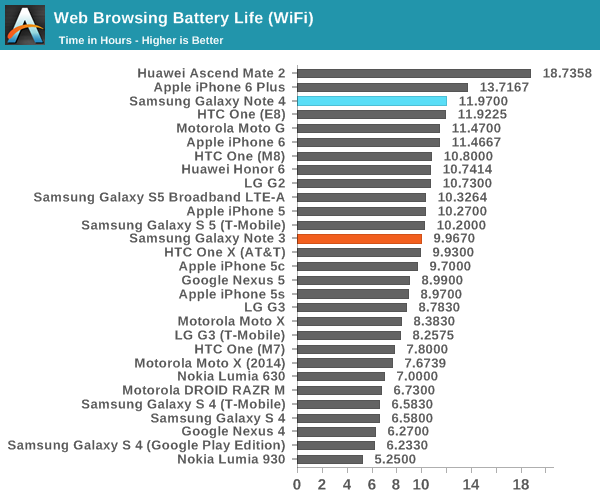
Our first test is the WiFi web browsing test, which loads a given set of web pages in a loop, with special emphasis taken in order to ensure that the test doesn’t penalize faster SoCs, which would have significant effects on our results. As one can see above, the Galaxy Note 4 has a noticeable uplift in battery life when compared to the Galaxy S5 and lasts significantly longer than the Galaxy Note 3. It doesn’t last quite as long as the iPhone 6 Plus, but few people should have issues getting through a full day of intensive use.
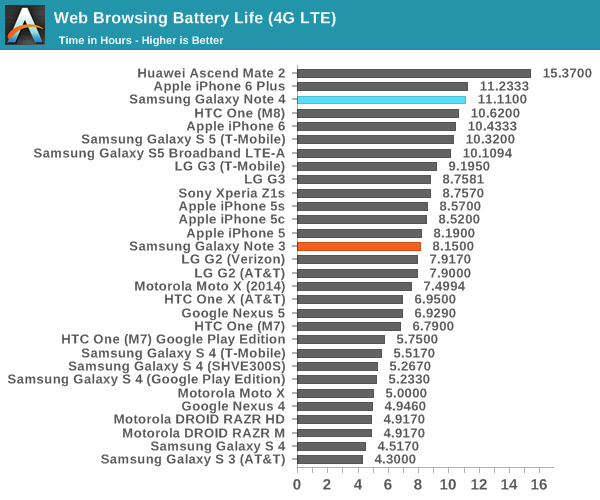
On LTE web browsing, a similar story plays out as the Galaxy Note 4 is able to keep up with the competition and delivers the massive improvement that we’ve generally seen from the transition to Snapdragon 801 and 805.
While the web tests are well-worn by now, we’ve added two additional tests to the battery life suite in order to get a better picture of SoC-bound battery life. To this end, we use an infinite loop of T-Rex on-screen to replicate a GPU-intensive scenario and Basemark OS II’s battery life test to simulate a CPU-intensive scenario.
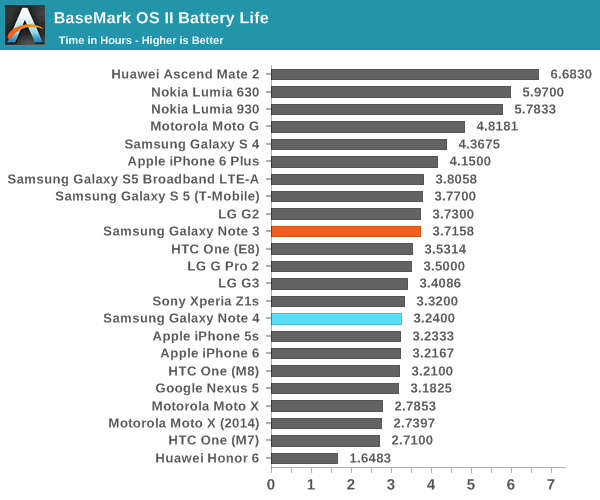
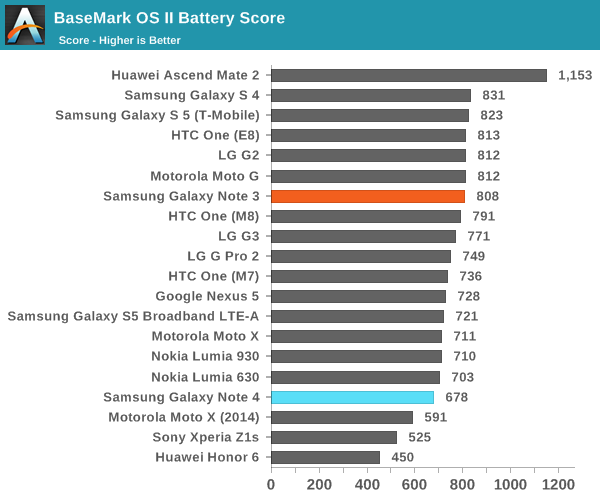
In the case of the Basemark OS II test, we see that battery life under a sustained task ends up a bit lower than we expect, which seems to suggest that in CPU-bound tasks the Note 4 doesn't have much better efficiency when compared to the Galaxy Note 3. This seems to be self-evident, as the CPUs are quite similar and the process technology used is largely similar when comparing the two devices.
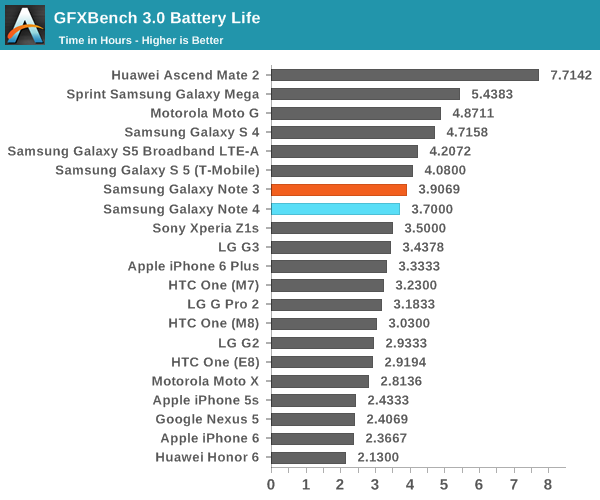
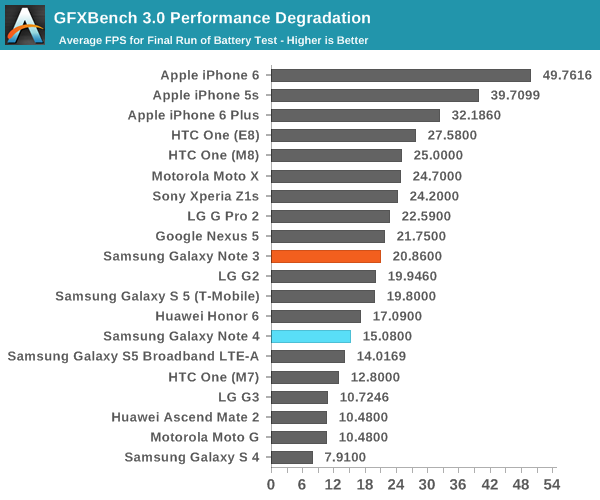
In GFXBench's endless rundown test we see that the Galaxy Note 4 trails behind in battery life when compared to the GS5 LTE-A, but looking at the end of run FPS it’s quite clear that the Galaxy Note 4’s larger surface area makes it possible to achieve greater performance.
Overall, battery life is quite good on the Galaxy Note 4. It’s a massive leap forward when compared to the Galaxy Note 3, but a relatively small one when compared to the Galaxy S5. Once again, we see that most of the benefits in battery life will come from scenarios where power draw isn’t strongly influenced by the display.
Charge Time
As a part of the overall battery life story, it's important to consider the time it takes for a battery to fully charge. If a phone's battery charges slowly then scenarios where charge time becomes crucial will severely hurt real-world battery life. For example, if one forgets to charge their phone at night, the rate at which the phone will charge the battery is a strong influence upon actual battery life. In order to test this, we measure power draw from the time that the device under test is plugged in until it reaches a given level of power draw that indicates that the battery is fully charged.
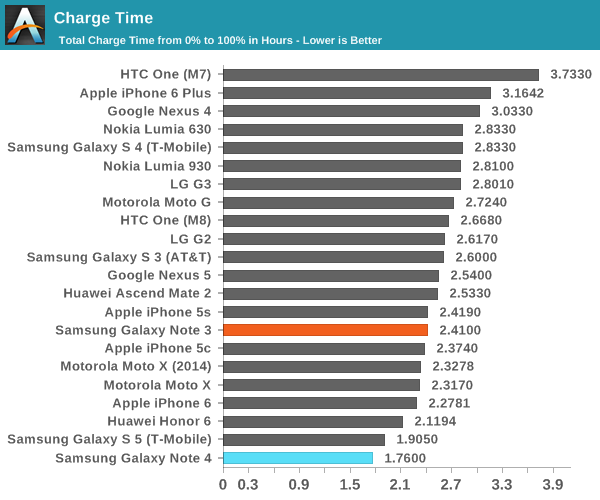
As one can see in the graph above, the adaptive fast-charge mechanism really works, although I don't see a huge benefit when compared to the Galaxy S5's charge time which was already incredibly fast. In the case of the Galaxy Note 4 it seems that it switches between a 9V, 1.64A mode and a 5V, 2A mode as needed, and most of the benefit would come from the first 50% or so of charging as power drops rapidly as the battery approaches full charge.










195 Comments
View All Comments
dakishimesan - Wednesday, October 15, 2014 - link
You can't ignore maximum brightness. OLED screens have a high contrast ratio because their black levels are very deep, which offsets the lower brightness to still give it a high ratio. But maximum brightness still matters for visibility outside.theduckofdeath - Wednesday, October 15, 2014 - link
You can however dismiss its importance. If the dynamic range is below the thousands on one tech and maybe above the millions on the other tech, other numbers suddenly become really, really irrelevant.JoshHo - Monday, October 27, 2014 - link
This is technically inaccurate. Outdoor visibility is primarily determined by maximum brightness and diffuse reflectance, not native contrast.jnb - Wednesday, October 15, 2014 - link
I played around with an iPhone 6 Plus and the Note 4 at Best Buy the other day. I thought there was a big difference in the display with the Note 4 being much better. It is interesting to see a review like this say there are basically equal. It goes to show that you should really look at them in person and form your own opinion. These numbers don't mean anything to an average person.melgross - Wednesday, October 15, 2014 - link
That's very misleading. While the blacks are just a small bit better than the best LCD displays, the whites are half as bright. In normal lighting, the much dimmer AMOLED displays will look fine, but outside, in direct sunlight, they will be washed out.The GS5 is definitely not more readable outside. So just go ahead and ignore reality. Brightness is directly responsible for readability outside. It's not magic.
Tams80 - Thursday, October 16, 2014 - link
It's not just brightness. I don't know what Samsung have done here, but Nokia CBD (proper CBD) increased sunlight readability without just increasing screen brightness.theduckofdeath - Thursday, October 16, 2014 - link
It's not "a small bit better", it's a much bigger difference than what you get between TN and IPS. 100's times bigger in fact.skinygeek - Wednesday, October 15, 2014 - link
Wondering how the Battery life of Exynos Variant would be . The 20nm Tech should give it an edge.danstek - Wednesday, October 15, 2014 - link
Is the graph comparing camera focus latency missing? Not showing up for me.juicytuna - Sunday, October 19, 2014 - link
It's there now, but unfortunately too late as most of the sites readership will miss out on knowing how awesomely fast the camera is.A stark contrast with the iPhone 6 review where the phase detect autofocus was put on pedestal and showered with confetti.